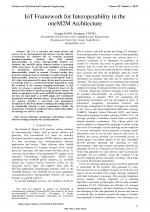| 2/2020 - 2 |
IoT Framework for Interoperability in the oneM2M ArchitectureKANG, S. |
| Extra paper information in |
| Click to see author's profile in |
| Download PDF |
Author keywords
inference mechanisms, information science, internet of things, semantic web, standardization
References keywords
semantic(15), internet(12), interoperability(8), ontology(5), computing(5), access(4)
Blue keywords are present in both the references section and the paper title.
About this article
Date of Publication: 2020-05-31
Volume 20, Issue 2, Year 2020, On page(s): 11 - 18
ISSN: 1582-7445, e-ISSN: 1844-7600
Digital Object Identifier: 10.4316/AECE.2020.02002
Web of Science Accession Number: 000537943500002
SCOPUS ID: 85087450714
Abstract
The IoT is expected that many devices and sensors can be interconnected and interact over the Internet. Conventional IoT solutions rely on vertically developed machine-to-machine solutions that yield limited interoperability. To ensure interoperability between IoT solutions, the oneM2M global initiative defines a horizontal M2M service layer. To provide more intelligent services, such as autonomous interaction services, semantic-level interoperability should be ensured. Previous studies have proposed solutions based on ontologies to realize semantic level interoperability. However, in dynamic environments such as IoT, where data generated by many devices must be processed, an ontology leads to a system performance degradation owing the overhead of the resource mapping mechanism. In this study, we propose a semantic IoT framework based on the Resource Description Framework graph extension scheme. We utilize an aggregator based on the oneM2M standard platform. All data are represented as an RDF graph, and reconfigured dynamically through semantic queries. The proposed semantic IoT gateway provides a user-based rule management mechanism via the Web, thereby enabling rule configuration to be dynamically tailored to user requirements. Finally, the performance is evaluated compared with a solution that utilizes an ontology in a real IoT system. |
| References | | | Cited By |
Web of Science® Times Cited: 1 [View]
View record in Web of Science® [View]
View Related Records® [View]
Updated today
SCOPUS® Times Cited: 3
View record in SCOPUS® [Free preview]
View citations in SCOPUS® [Free preview]
[1] Behind the definition of Industry 5.0: a systematic review of technologies, principles, components, and values, Ghobakhloo, Morteza, Iranmanesh, Mohammad, Tseng, Ming-Lang, Grybauskas, Andrius, Stefanini, Alessandro, Amran, Azlan, Journal of Industrial and Production Engineering, ISSN 2168-1015, Issue 6, Volume 40, 2023.
Digital Object Identifier: 10.1080/21681015.2023.2216701 [CrossRef]
[2] IoT based Smart Healthcare Monitoring Systems: A Review, Tiwari, Divyanshu, Prasad, Devendra, Guleria, Kalpna, Ghosh, Pinaki, 2021 6th International Conference on Signal Processing, Computing and Control (ISPCC), ISBN 978-1-6654-2554-4, 2021.
Digital Object Identifier: 10.1109/ISPCC53510.2021.9609393 [CrossRef]
[3] Semantic Interoperability and Reusability in IoT: a Systematic Mapping Study, Alsaeh, Amal, Sezen, Arda, 2024 8th International Artificial Intelligence and Data Processing Symposium (IDAP), ISBN 979-8-3315-3149-2, 2024.
Digital Object Identifier: 10.1109/IDAP64064.2024.10710911 [CrossRef]
Disclaimer: All information displayed above was retrieved by using remote connections to respective databases. For the best user experience, we update all data by using background processes, and use caches in order to reduce the load on the servers we retrieve the information from. As we have no control on the availability of the database servers and sometimes the Internet connectivity may be affected, we do not guarantee the information is correct or complete. For the most accurate data, please always consult the database sites directly. Some external links require authentication or an institutional subscription.
Web of Science® is a registered trademark of Clarivate Analytics, Scopus® is a registered trademark of Elsevier B.V., other product names, company names, brand names, trademarks and logos are the property of their respective owners.
Faculty of Electrical Engineering and Computer Science
Stefan cel Mare University of Suceava, Romania
All rights reserved: Advances in Electrical and Computer Engineering is a registered trademark of the Stefan cel Mare University of Suceava. No part of this publication may be reproduced, stored in a retrieval system, photocopied, recorded or archived, without the written permission from the Editor. When authors submit their papers for publication, they agree that the copyright for their article be transferred to the Faculty of Electrical Engineering and Computer Science, Stefan cel Mare University of Suceava, Romania, if and only if the articles are accepted for publication. The copyright covers the exclusive rights to reproduce and distribute the article, including reprints and translations.
Permission for other use: The copyright owner's consent does not extend to copying for general distribution, for promotion, for creating new works, or for resale. Specific written permission must be obtained from the Editor for such copying. Direct linking to files hosted on this website is strictly prohibited.
Disclaimer: Whilst every effort is made by the publishers and editorial board to see that no inaccurate or misleading data, opinions or statements appear in this journal, they wish to make it clear that all information and opinions formulated in the articles, as well as linguistic accuracy, are the sole responsibility of the author.



